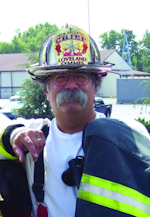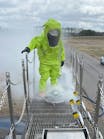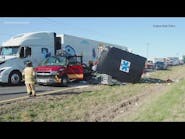Close Calls: Hardly Just a Gas Leak — Part 1
The hand wave. You’ve all seen it and probably have done it. It’s when the tones go off and the dispatcher tells you to respond to something that may not be on your agenda of what you want to do today. A person with a stubbed toe. A smoke alarm chirping. Or maybe it’s the ever-popular gas leak. You give it the hand wave, acknowledging the incident while subtlely dismissing its seriousness. And while any and all of those calls require us to be at our best, the gas leak needs to be respected as you would a full first-alarm fire.
Gas leak = big deal
When toned out on a gas leak, it’s because of the possibility of patient rescue or, of course, the gas exploding. When the dispatcher alerts us to a gas leak, it’s essentially a warning of what could happen next, and fire departments must be prepared for any situation.
A few considerations:
- What companies/apparatus respond on your department’s gas leak alarms?
- Where do responding companies stage?
- What/who goes into the hot zone and what/who stays out?
- What is the hot zone for a leak, explosion and/or collapse?
- What PPE, equipment and tools are required for members operating in the hot zone?
- What are your meter capabilities? Can it read percentages?
- What do companies in staging do if something goes wrong at the scene?
- What’s the water supply plan?
- What’s the plan for victims?
- What are the (or could there be) areas that allow the gas to travel (void spaces, pipes)?
- What’s the vent plans?
- What’s the relationship with your gas company?
- When did your department last drill with the gas company?
- What will the gas company do when they arrive?
- Do they understand your command operations?
- Do you understand the gas company expectations?
Gas leaks can be complicated because we’re responding into a serious unknown—and because of that, we must take the opportunity to prepare and train beforehand.
Historic and recent gas leaks
Seattle made headlines in 2016 after an explosion at the scene of a reported gas leak resulted in several Seattle firefighters being injured. A building that housed a bagel shop and a beauty salon in the popular NW 23rd Street shopping district was reduced to rubble, and its smoldering roof was tossed across the road.
Other communities such as Poland, OH; Prince George’s County, MD; Haverstraw, NY; and Philadelphia have all experienced gas leaks resulting in explosions.
Most recently, FDNY Battalion Chief Mike Fahy was killed in the line of duty at the scene of a gas leak in the Bronx. FDNY firefighters responded to a call about the smell of gas. Firefighters discovered what looked like a marijuana grow house in the structure and reported it to police. FDNY and NYPD members were evacuating nearby buildings when the explosion occurred. Chief Fahy was doing his job—commanding operations from the street—when he was struck by flying debris and killed. RIP, Chief.
One major gas leak—and subsequent explosion—that grabbed my attention happened on Dec. 27, 1983, back when I was a newly promoted assistant chief in Buffalo, NY. Five Buffalo firefighters and two civilians were killed when a propane blast leveled a warehouse. The explosion damaged 12 city blocks and remains the department’s deadliest fire in modern history.
Former Buffalo Fire Commissioner Mike Lombardo wrote a piece for Firehouse, providing his perspective on this fire. To read the account, visit the online version of this article at firehouse.com/12284770.
Gas leak and explosion
While all of the above incidents—and so many more—are critical to our learning, let's focus on an event that happened in Adams County, PA, within the first-due area of the Alpha Fire Company (AFC).
The AFC is a nonprofit volunteer fire and EMS company that protects the community of Littlestown, PA, and its surrounding areas. AFC responds to approximately 350 fire and rescue incidents and 800 EMS runs a year, with two engine companies, an engine tanker, a heavy rescue and related support apparatus. Its initial response for a gas leak is an engine, rescue and BLS ambulance.
On March 4, 2016, the Alpha firefighters responded to a gas leak, just as they had many times before. Additional agencies that assisted in this incident included the Southeastern Adams Volunteer Emergency Services, Hanover Hospital ALS, Adams Regional EMS, Taneytown EMS, STAT Medevac and Life Lion helicopters, Littlestown Police, Adams County Department of Emergency Services 9-1-1 Dispatchers and Pennsylvania State Police Fire Marshal.
While AFC crews searched the structure for a possible occupant, an explosion occurred, injuring four firefighters. Two firefighters suffered burns on their hands and ears, and two firefighters suffered more minor injuries.
Here we’ll review the incident from the perspective of AFC Deputy Chief Justin Myers, who was the incident commander that day, and then offer lessons learned from the interior firefighters—Ray Boyd, Michael Cahill, Jay Ingle and Dan Healy.
IC Myers’ perspective
The initial dispatch for an inside gas investigation (odor of gas) was for Engine 202, Rescue 20 and Ambulance 20A. Engine 202 arrived on location to find normal conditions of a single-story, wood-frame residence. Columbia Gas and Littlestown police were already on scene.
I assumed command and crews began to investigate. The gas company representative advised that he had tracked the leak to the residence and had readings on the exterior and underground. The leak was underground and could not be controlled with the valve at the meter. He advised that the neighbors had not seen the elderly female resident that morning and no one answered the door. There was a newspaper in the driveway and a car in the attached garage. The decision was made to search for the resident.
The exterior of the home was checked and an unlocked window was found on the garage. The window was opened, and the gas representative had readings inside the garage. One firefighter entered the window in full PPE and on air (SCBA) with a four-gas monitor. The monitor almost immediately went into low alarm. The firefighter manually released the overhead garage door, and his partner entered the garage.
The crew forced the interior garage door and entered the residence. As they searched, they opened windows and the front door. The gas monitor was now in an over-range condition. A second meter was obtained from the Rescue. The engine was moved from a staging position to the closest hydrant.
The crew continued the search and soon advised that the search of the first floor was negative and they were unable to locate the basement door. The 360 survey had revealed no exterior basement access but there were small ground-level windows and operating vents from a high-efficiency furnace or water heater.
An additional crew of two entered to assist in locating the stairwell. The crews soon found that the garage door they entered through had blocked the basement door with its swing. The crew went to the basement and found no resident.
Prior to exiting the basement, they noted that the furnace was running and the exhaust motor was running. The decision was made to shut down the unit to eliminate an ignition source, and then exit the structure. As the main breaker (less than 30 inches from the fan motor) was flipped, the crew witnessed the ignition of the air around them. They dove to the floor.
The two most severely injured firefighters were not wearing their gloves and attempted to cover their exposed skin. They were closest to the stairwell.
I watched the lights go out through the open front door and it seemed like slow motion as the explosion occurred, sending a fireball through the home, slamming the doors shut and blowing out the Bravo wall at the roof line. I thought the crew was gone!
Moments later the sounds of painful screams and a transmitted mayday call were the best thing I could have heard. They were alive. I forced the jammed front door open and met the crew as they were exiting the basement. Only a small amount of fire, issuing from the HVAC vents, remained on the first floor. The crew exited the structure and an attack line was pulled by the additional personnel on location. I radioed the communications center for a full structure fire assignment and additional EMS units.
On scene, crews and additional units assisted with extinguishing the remaining fire, caring for the injured firefighters and performing the secondary search.
Two of our firefighters suffered burns to their hands and ears, the other two firefighters had burns to smaller areas. EMS provided the necessary care, and two firefighters were flown to the burn center.
The home suffered extensive damage. The path of fire up the basement steps and through the kitchen was evident from the scorched ceiling, walls and the floor. While most of the fire burned out after the initial flash, overhaul revealed smoldering fire and burned materials from the basement to roof trusses.
Learning from the experience
It was later determined that the natural gas supply line was separated below the meter and was leaking underground, allowing the gas to enter the structure. The resident had left the house earlier in the morning and was safe.
Myers noted that it was his opinion that the house was filled with dangerous gas mixtures well before the arrival of the fire department. It is amazing that the mixture had not found an ignition source before the resident left earlier in the morning. Anything could have caused an explosion. A light switch, electronic device cycling on and off, or a static spark were just waiting for the right explosive mixture.
Firefighter Ingle had his gloves partially on at the time of the blast. “I took my gloves off once inside to open the windows so we could ventilate along the way,” he said. “I couldn’t work the latch with my fire gloves on and was actually putting them back on (with one halfway on) when the explosion occurred.”
Firefighter Boyd was the firefighter with the worst of the burns. The incident really got him thinking, particularly about not taking anything for granted. Boyd had also taken his gloves off to operate window latches. Obviously, not putting the gloves back on was a mistake, but it took awhile to get past thinking it was all his fault.
Boyd wants to pass on an important message to other new firefighters: Don't think it can't happen to you. And if it does, don't be afraid to ask for help. Sometimes the injuries are more than just the burns. He also expressed how thankful he was to the brotherhood of the fire service, all the people who came and visited him in the hospital and helped him with his follow-up care and appointments.
Boyd is back to full duty and actively running calls again. He is a volunteer and wants to become a career firefighter—and is working toward that. On this particular incident, four of the nine responders were career firefighters in other jurisdictions, which is typical for the area—a nice perk their fire company enjoys, having full-timers as volunteers in their community.
Firefighter Cahill had a tiny hole in one of his gloves and suffered burns on his hand as a result. “I must admit, I would have never turned in my gloves for such a tiny hole, but I wasn't even aware of it,” he said. The key here: Inspect your gear, and if anything is wrong with it—even a tiny hole—get it fixed, or have it replaced.
Cahill further states, “Being in full gear, on air, saved our lives. Searching for an occupant that evidence indicated was home was the right call, in my opinion. Opening all the doors and windows as we went likely kept the house from coming down on top of us. Even us having clean gear played a role.”
Firefighter Dan Healy said of the event, “I’ve often wondered if, when the need arises, I would remember or have the wherewithal to call the mayday, but after the fuel was completely consumed, I looked up to see if everyone was moving, and immediately called the mayday, which just goes to show that doing it over and over in a training environment pays off. I didn’t have to think about it; it was a ‘muscle memory’ reaction. It just happened the way it was supposed to.”
One critical point worth looking at is the response of this department (and yours) to a reported inside gas leak. Some departments send a full first-alarm structural fire response, which is the right answer. It’s a GAS leak and gas EXPLODES, so why WOULDN’T a department send a full first alarm?
Any answers other than “we should” are not considering the incident potential for the civilians and firefighters alike. Imagine if the AFC sent a single engine without a meter and none of the members were geared up. This would be an entirely different story.
The crews were extremely lucky to have survived this event. Even the personnel who were on the exterior were lucky that the building did not completely explode, with a debris field, injuring them all. Remember, exterior debris from the explosion is what took the life of FDNY Battalion Chief Fahy in the Bronx, as previously noted.
Additional lessons from the crew:
- Don’t be complacent—always wear your PPE and make sure it is in excellent condition before the next run.
- Conduct a size-up and then trust your gas-detection equipment and understand your readings; adjust tactics and PPE/SCBA levels accordingly.
- Establish a water supply plan initially. Don’t wait until the explosion to get set up at the hydrant; be ready to flow water.
- Follow established priorities and conduct a risk/benefit analysis. Address the life hazard and then work to minimize the potential for property loss.
- A tragic event like this impacts much more than just the injured personnel and on-scene firefighters. Family, friends and the community are affected. You can’t provide and care for your family or protect the citizens who rely on you if you don’t use your PPE and training to survive.
Final thoughts
Next month we’ll review some suggested fire department responses to gas-related emergencies, including incidents with a report of a gas leak, but no fire or explosion, as well as incidents where an explosion has already occurred.
Our sincere thanks to the officers and members of the Alpha Fire Company, Fire Chief Chris Morgret and President Steve Laughman. Additional thanks to Deputy Chief Justin Myers and Firefighters Michael Cahill, Ray Boyd, Dan Healy and Jay Ingle.
Online Exclusive: Reflections on the Buffalo Explosion
One major gas leak—and subsequent explosion—that grabbed my attention happened on Dec. 27, 1983, back when I was a newly promoted assistant chief in Buffalo, N.Y. Five Buffalo firefighters and two civilians were killed when a propane blast leveled a warehouse. The explosion damaged 12 city blocks and remains the department’s deadliest fire in modern history.
Former Buffalo Fire Commissioner Mike Lombardo wrote a piece for Firehouse, providing his perspective on this fire.
The night of December 27, 1983. I was a pretty new firefighter. At 20:23 hrs, a full assignment was dispatched to North Division and Grosvenor streets. The three engines, two trucks, rescue and 3rd Battalion were responding to a report of a large propane tank leaking in a building. Engine 32 arrived and reported nothing showing, but they were talking to some workmen from the four-story, heavy-timber warehouse (approximately 50 x 100 feet). Truck 5, Engine 1 and BC Supple arrived right behind E-32.
Thirty-seven seconds after the chief announced his arrival, there was a tremendous explosion. It completely leveled the four-story building. It demolished many buildings on four different blocks. It seriously damaged buildings that were over a half a mile away. The ensuing fireball started buildings burning on a number of streets. A large gothic church on the next block had a huge section ripped out of it as if a great hand carved out the middle.
A 10-story housing project a couple blocks away had every window broken and some had even more damage. Engine 32 and Truck 5's firehouse, which was a half mile away or so, had all its windows shattered. This was, I'm sad to say, just the property damage. The explosion killed the five members of Truck 5. Firefighters Mike Austin, Mickey Catanzaro, Red Lickfeld, Tony Waszkielewicz and Matty Colpoys were killed instantly. Two civilians were also killed, neighbors of the warehouse who were in their living room watching TV. Eleven firefighters were injured. Several, including Battalion Chief Harvey Supple (a dear friend of Commissioner Lombardo's), were critically injured. Over 150 civilians were transported to hospitals for injuries suffered in the explosion. Scores more were treated at the scene.

Billy Goldfeder
BILLY GOLDFEDER, EFO, who is a Firehouse contributing editor, has been a firefighter since 1973 and a chief officer since 1982. He is deputy fire chief of the Loveland-Symmes Fire Department in Ohio, which is an ISO Class 1, CPSE and CAAS-accredited department. Goldfeder has served on numerous NFPA and International Association of Fire Chiefs (IAFC) committees. He is on the board of directors of the IAFC Safety, Health and Survival Section and the National Fallen Firefighters Foundation.






